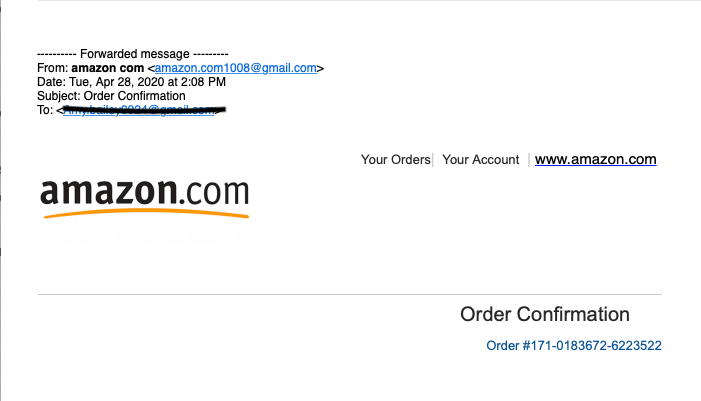If you got an email like this, you would think it is from Amazon.

Only on a closer look will you see the mistakes.
- The name of the email sender is Amazon Com, and the actual address is a Gmail address.
- Your Orders and Your Account are not links, they are just words.
- The Amazon logo is just a line. Whereas, the real Amazon logo is an arrow forming a smile from A to Z.
This email is what’s known as a phishing email. Phishing emails are emails from scammers trying to get access to your accounts to steal your information.
So, how do you protect yourself from getting scammed? There are common distinctions that set phishing emails apart from the real deal.
First is the email address. An email address is broken into 2 main parts: the local part, which is before the @ symbol, then the domain part, which is after the @. Big corporations usually have their company name as the domain. Keep in mind, small companies or businesses might use a gmail address, which is perfectly fine. This point isn’t a rule, but something to consider and pay attention to.
Second, look at the words used. Most phishing email will have misspelled words, or bad grammar. A common distinction is the capitalization of nouns.
Third, there is usually a sense of urgency, like you need to update your billing details. In this example, “Amazon” wanted to warn the user that an iPhone was recently purchased, and is getting shipped. If this wasn’t order, then the user was instructed to call the 805 number at the bottom of the email. Phishing email will usually have an urgent matter for you to address, and will provide a link in the email to click on. Never click on the link. You will either be taken to a fraudulent site, looking like the company again, or the link will try to install malware on your machine.
As time goes on, scammers are adjusting their ways to trick us. Keep in mind, there are ways to protect yourself.
Safeguard against Phishing
Always have an internet security program installed, updated, and running on your device at all times. This will protect you in real time. Depending on how often you use your device, you may want to run a full scan every couple of days to every week.
Whenever companies provide it, use Two Factor Authentication for everything. In additional to your password, you will receive a one-time code to verify it is you accessing the account.
Be mindful what you click on in the emails. When in doubt, never download an attachment, and never click a link in the email. Attachments can contain malware, which can infect your computer. And any link can take you to a malicious site to steal your information. If you’re unsure, call the company or open a browser and type in the website yourself.
Use a password manager program to safeguard your passwords. And, within reason, change your passwords regularly.
If you think you’ve been scammed by a phishing email, please contact the Federal Trade Commission to open a claim.
If you would like to discuss how to further protect yourself, or if you would like to get started using a password manager program, please give us a call!